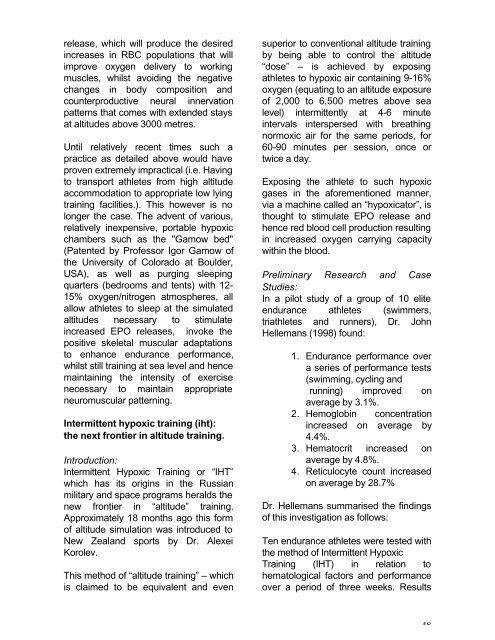MAXIMISING OLYMPIC DISTANCE TRIATHLON PERFORMANCE ...
MAXIMISING OLYMPIC DISTANCE TRIATHLON PERFORMANCE ...
MAXIMISING OLYMPIC DISTANCE TRIATHLON PERFORMANCE ...
You also want an ePaper? Increase the reach of your titles
YUMPU automatically turns print PDFs into web optimized ePapers that Google loves.
elease, which will produce the desiredincreases in RBC populations that willimprove oxygen delivery to workingmuscles, whilst avoiding the negativechanges in body composition andcounterproductive neural innervationpatterns that comes with extended staysat altitudes above 3000 metres.Until relatively recent times such apractice as detailed above would haveproven extremely impractical (i.e. Havingto transport athletes from high altitudeaccommodation to appropriate low lyingtraining facilities.). This however is nolonger the case. The advent of various,relatively inexpensive, portable hypoxicchambers such as the "Gamow bed"(Patented by Professor Igor Gamow ofthe University of Colorado at Boulder,USA), as well as purging sleepingquarters (bedrooms and tents) with 12-15% oxygen/nitrogen atmospheres, allallow athletes to sleep at the simulatedaltitudes necessary to stimulateincreased EPO releases, invoke thepositive skeletal muscular adaptationsto enhance endurance performance,whilst still training at sea level and hencemaintaining the intensity of exercisenecessary to maintain appropriateneuromuscular patterning.Intermittent hypoxic training (iht):the next frontier in altitude training.Introduction:Intermittent Hypoxic Training or “IHT”which has its origins in the Russianmilitary and space programs heralds thenew frontier in “altitude” training.Approximately 18 months ago this formof altitude simulation was introduced toNew Zealand sports by Dr. AlexeiKorolev.This method of “altitude training” – whichis claimed to be equivalent and evensuperior to conventional altitude trainingby being able to control the altitude“dose” – is achieved by exposingathletes to hypoxic air containing 9-16%oxygen (equating to an altitude exposureof 2,000 to 6,500 metres above sealevel) intermittently at 4-6 minuteintervals interspersed with breathingnormoxic air for the same periods, for60-90 minutes per session, once ortwice a day.Exposing the athlete to such hypoxicgases in the aforementioned manner,via a machine called an “hypoxicator”, isthought to stimulate EPO release andhence red blood cell production resultingin increased oxygen carrying capacitywithin the blood.Preliminary Research and CaseStudies:In a pilot study of a group of 10 eliteendurance athletes (swimmers,triathletes and runners), Dr. JohnHellemans (1998) found:1. Endurance performance overa series of performance tests(swimming, cycling andrunning) improved onaverage by 3.1%.2. Hemoglobin concentrationincreased on average by4.4%.3. Hematocrit increased onaverage by 4.8%.4. Reticulocyte count increasedon average by 28.7%Dr. Hellemans summarised the findingsof this investigation as follows:Ten endurance athletes were tested withthe method of Intermittent HypoxicTraining (IHT) in relation tohematological factors and performanceover a period of three weeks. Results48


